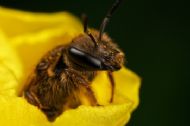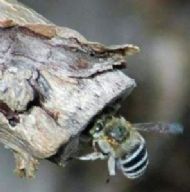 Taff's Well and Nantgarw Allotments and Community Garden Project | sitemap | log in Taff's Well and Nantgarw Allotments and Community Garden Project | sitemap | log in
|
 |
||
| This is a free Spanglefish 1 website. | ||
Party in the Hive? 23 June 2010 Party in the Hive? No Thanks, I’m a Solitary Bee Contribution by Liz Johns A solitary person
 I am, by nature, a solitary person. I take little pleasure in mingling at parties and in having to make small talk. Any more than six people in a social group and I instinctively withdraw. I avoid crowds wherever possible and will not be found on the commuter train without a book to disappear into or an ipod to block out the surrounding chatter. Anti-social? Perhaps. But I prefer to call it solitary. As solitary as a bee. What? Surely bees are one of the most social and communal creatures around? Some are yes, but not all. I have great pleasure in introducing the Solitary Bee.
A solitary bee
 These bees collect pollen, but do not make honey. And instead of living in hives, they make an individual nest for each egg laid. These nests can be found in holes in wood, tunnels in the ground, crumbling mortar, and other hidey-holes. Solitary bees are harmless and do not sting. Also, they will refuse invitations to any social gatherings of more than six bees.
I’m pretty sure that solitary bees nest in the wooden walls of our house. I’ve noticed in the summer a strange insect – a cross between a wasp and a bee – sneaking in between the wooden cladding and buzzing, then leaving at the end of the summer.
Name that bee
Solitary bees have great names: Mason bees, Leafcutters, Mining bees, White faced bees, Carder bees, Cuckoo bees, to name but a few.
Are solitary bees uncommon?
No, the opposite in fact. There are more than 20,000 known species of bee in the world, by far the greatest portion (90%) of these are solitary.
We love solitary bees
Make them feel at home by building houses for them, just like Sainsbury’s in the UK that has set up ‘rooftop hotels‘ to encourage solitary bees.
By Liz Johns |  |
|
 | ||